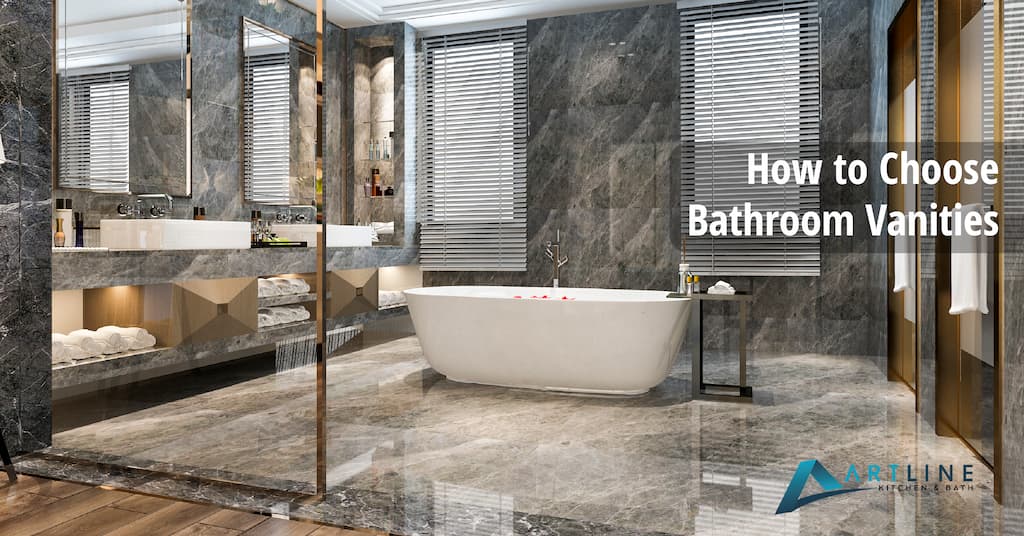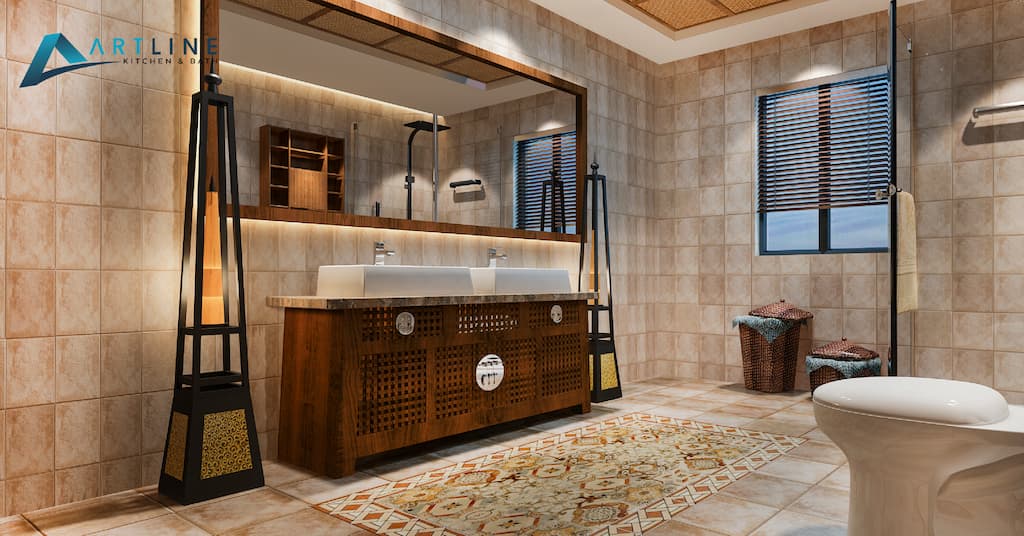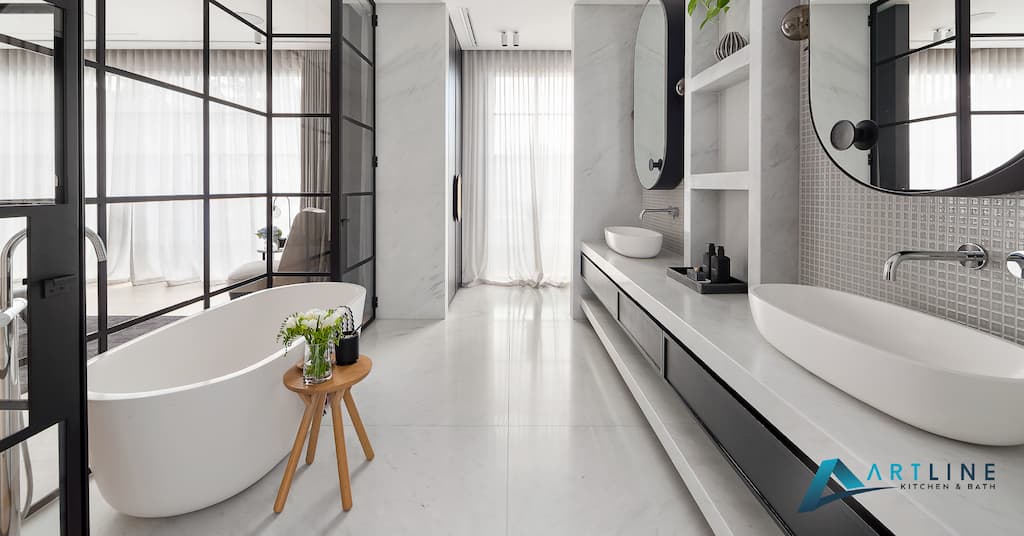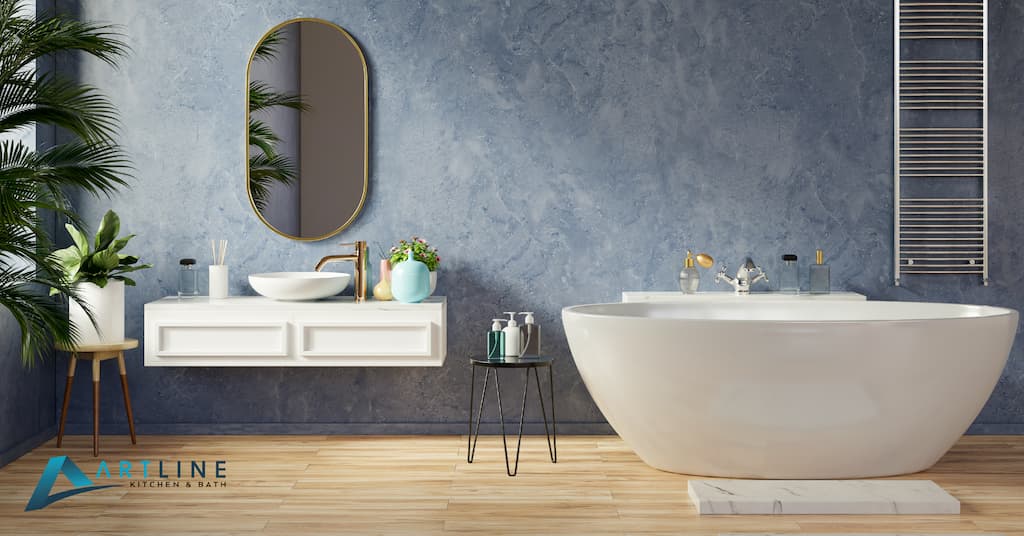Bathroom vanities typically consist of a sink, countertop, and storage space. Bathroom remodeling refers to renovating or updating a bathroom space to improve its functionality, aesthetics, and overall appeal.Â
Choosing the right vanity for bathroom remodeling projects can significantly impact the look and functionality of the bathroom. A well-selected vanity can transform the bathroom aesthetically by enhancing the overall design theme.Â
The right vanity offers storage solutions, helps optimize space usage, and improves organization. It contributes to a more efficient and enjoyable bathroom experience. Careful consideration of size, style, material, and layout is essential when selecting a vanity for bathroom remodeling projects.Â
This article will cover size and layout selection, material selection, design considerations, color trends and finishes, innovative storage solutions, user accessibility, ergonomics, incorporating technology, eco-friendly vanity options, water and energy conservation, and customization of vanities.Â
Table of Contents
ToggleBathroom Vanity Ideas According to Size and LayoutÂ
When considering bathroom vanity ideas for remodeling, the size and layout selection are crucial for functionality and aesthetics. You should select a vanity that fits the bathroom’s dimensions and layout.Â
It is essential to adjust the size of the vanity to the available space in the bathroom. For example, if you have a smaller bathroom, typically 5’ by 8’ (1.524 by 2.438 m), you will want to maximize available space and prevent the area from feeling cramped. A compact or wall-mounted vanity ranging from 24” to 30” (60.96 to 76.2 cm) would be best.Â
A single-sink freestanding or floating vanity is recommended in a medium-sized 8’ by 10’ (2.438 by 3.048 m) bathroom. The vanity width typically ranges from 36” to 48” (91.44 to 121.92 cm). In a large 10’ by 12’ (3.048 by 3.657 m) or larger bathroom, it is recommended to install a double-sink or L-shaped vanity. Their vanity width typically ranges from 60” to 72” (152.4 to 182.88 cm).Â
Layout selection depends on numerous factors, such as the bathroom’s shape and existing fixtures. A single-sink vanity positioned against one wall may be the most practical choice in narrow bathrooms, allowing for easy movement within the space. An L-shaped or floating vanity can add visual interest while optimizing functionality in larger bathrooms with more square footage.Â
Different aspects need to be considered when measuring the available space and planning for traffic flow and usability:Â
- Measurement: Use a measuring tape to determine the dimensions of the bathroom. Measure any alcoves, corners, or irregularities in the layout.Â
- Key Fixtures: Be aware of the locations of key fixtures such as the toilet, bathtub, shower, and door swings. Also, consider any obstructions like windows or outlets.Â
- Traffic Flow: To plan for traffic flow, visualize how people move through the space. Ensure there is enough space around fixtures and between items to allow for easy movement. You should aim for clear pathways and avoid placing vanities or other furniture in the way of natural traffic flow.Â
- Usability: What kind of usability is planned for the bathroom? For example, ensure enough room to open cabinet doors and drawers comfortably.Â
- Utilizing Bathroom Design Software: Bathroom design software or online planning tools can help visualize different layout options and configurations. The tools can provide 3D renderings and allow you to experiment with various arrangements before making final decisions.Â
- Consulting Professionals: If you are still deciding on the best layout for your bathroom, consider consulting with a professional designer or contractor. They can help you navigate the different aspects of bathroom remodeling, choose the perfect bathroom vanity, and ensure that the space is functional and aesthetically pleasing.Â
Consider the placement of plumbing lines and electrical outlets. Ensure enough space for plumbing connections, including drains and supply lines. This will ensure a seamless installation and functionality of the chosen layout.Â
Choosing the appropriate size and layout ensures that the vanity seamlessly fits into the space, maximizing the available space and complementing the bathroom’s overall design aesthetic.Â
Bathroom Vanity Ideas According to Material
The material selection for the bathroom vanity should be based on durability and style. Materials such as wood, metal, engineered stone, glass, ceramic, natural stone, and marble have unique characteristics that influence a vanity’s longevity and visual appeal.Â
Wood exudes warmth and natural charm, while metal offers a sleek and modern aesthetic. Engineered and natural stone provide durability, although engineered stone is more versatile in design.Â
The chosen material impacts the vanity’s durability, maintenance requirements, and overall aesthetic. Wood vanities may require periodic sealing to protect against moisture damage, whereas metal options often boast exceptional resistance to water and corrosion. Engineered stone offers ease of maintenance and resistance to stains and bacterial growth.Â
The chosen finish impacts a vanity’s resilience against environmental factors. By ensuring that the finish can withstand water, scratches, and daily wear, the vanity will maintain its pristine appearance over time. By prioritizing the finish’s resistance to wear and tear, you enhance the vanity’s longevity and preserve its aesthetic appeal in the bathroom.

Bathroom Vanity Ideas According to Design, Style, and Type Considerations
Design, style, and type considerations are an opportunity to infuse your space with a distinct design statement. Exploring the spectrum of vanity styles, from the sleek lines of modern designs to the timeless elegance of traditional ones, is a key consideration. Each style adds a different character to the bathroom and sets a different tone for the entire space.Â
More modern vanities create a sophisticated, urban vibe and luxury. Transitional vanities, on the other hand, create more versatile sophistication by blending modern simplicity with traditional accents. Traditional vanities exude warmth and refinement.Â
Countertop and sink selections are also essential as they contribute to the vanity’s functionality and are focal points in the design scheme. The choice can elevate the overall aesthetic and accommodate your practical needs.Â
There are various options for countertops and sinks, such as granite, marble, quartz, and concrete countertops. The selection for sinks includes undermount, vessel, and pedestal sinks.Â
Lastly, it is essential to integrate the vanity seamlessly into the bathroom’s design theme. This ensures a cohesive visual narrative. Harmonizing elements like finishes, hardware, and accessories can create a unified ambiance that reflects your style and enhances the space’s overall appeal.Â
Some key aspects to consider for integrating vanities into the overall design are coordinating the bathroom to have a complementary color palette, selecting hardware to match other metal accents, selecting a mirror for the vanity style, and integrating lighting.
To tie the space together, consider incorporating a matching backsplash or wall treatment behind the vanity area. Lastly, consider adding accessories and DĂ©cor, like candles, vases, and artwork.Â

Bathroom Vanity Ideas According to Color Trends and FinishesÂ
Color trends and finishes can help when deciding on a bathroom vanity for your bathroom design. These trends and preferences can vary based on personal preferences and design styles.Â
Neutral tones, which include popular colors like white, beige, and grey, are timeless and versatile. They provide a clean, airy feel and easily blend with various design schemes.Â
Bold colors are popular, including vibrant hues like navy blue, emerald green, and deep plum. They are gaining popularity as statement-making choices for bathroom vanities. They add personality and drama to the space and are focal points.Â
A popular finish for vanities is natural wood. It embraces natural wood’s warmth and texture, which adds an organic and rustic charm to bathroom vanities and adds warmth and character to the space.
Matte finishes offer a modern and sophisticated look to bathroom vanities. They are sleek and elegant and provide a contemporary edge to the design.Â
High-gloss finishes in bold colors or classic neutrals bring a sleek and polished appearance. They reflect light beautifully and create a luminous and luxurious atmosphere in the bathroom.Â
Textured finishes, such as hammered metal, brushed finishes, or embossed patterns, add texture to vanity surfaces. They add visual interest and depth to the design, elevating the overall look of the vanity and creating unique focal points.Â
Bathroom Vanity Ideas with Innovative Storage Solutions
Innovative storage solutions are essential for maximizing the functionality and organization of bathroom vanities during remodeling. There are some innovative storage ideas and configurations for bathroom vanities.Â
To efficiently store and organize bathroom supplies, add vertical pull-out shelves inside the vanity cabinet. These shelves effectively utilize the vertical space while giving the outside a neat look.Â
Incorporate open shelving below the vanity countertop to display decorative items, folded towels, or baskets for additional storage. It adds a decorative touch to the vanity area while providing convenient access to frequently used items.Â
Integrate hidden compartments or pull-out racks within the vanity cabinet to conceal items such as hairdryers, curling irons, or electric shavers. They help to declutter the countertop and maintain a clean, streamlined look.Â
Install built-in organizers, like acrylic trays or bins, within the vanity drawers to sort and store smaller items. These organizers help prevent small items from getting lost or mixed.Â
Assess the solutions for organizing your toiletries, towels, and other essentials to keep the bathroom clutter-free.
Add drawer dividers to your drawers and shelves. They help organize your toiletries, makeup, and grooming essentials neatly and prevent items from shifting and sliding around.Â
Utilize tiered storage trays or baskets to arrange towels, hand towels, and washcloths. These trays maximize vertical space and make it easy to access different-sized linens.Â
Another option is to install rotating lazy Susans inside the vanity cabinet to maximize storage space and provide easy access to items stored in the back. They allow for the efficient organization of bottles, jars, and containers, reducing clutter and optimizing storage capacity.Â
You can also incorporate pull-out hampers or laundry bins within the vanity cabinet. This allows for convenient storage of dirty towels or laundry. They keep the bathroom tidy, reducing floor clutter and maintaining a clean appearance.Â
Lastly, you can install magnetic strips on the interior walls of vanity drawers or cabinets to securely hold metal grooming tools. This innovative storage solution keeps small items organized and easily accessible.Â

Bathroom Vanity Ideas with User Accessibility and Ergonomics
Some tips for user accessibility and ergonomics for selecting vanities include height consideration, sink placement, easy-to-reach storage, user-friendly hardware, and grab bars and support rails.Â
You should opt for a vanity with a comfortable height that suits the needs of all users. Standard vanity heights range from 30 to 36 inches, but adjustable or custom-height vanities can accommodate individuals with varying preferences or mobility challenges.Â
An accessible sink placement allows easy access and comfortable use. Consider options like wall-mounted or pedestal sinks, which offer ample legroom and allow wheelchair users to maneuver closer to the sink.Â
For Durable and slip-resistant surfaces for bathrooms, you should opt for materials like textured tiles or non-slip flooring around the vanity to minimize the risk of injuries and ensure safety and comfort.Â
Easy-to-reach storage, such as pull-out drawers, adjustable shelves, or built-in organizers, facilitates organizing and retrieving items without straining or bending.Â
Consider installing ample lighting to enhance visibility and promote user comfort. To minimize shadows and improve visibility, incorporate task lighting above or around the mirror.Â
Grab bars and support rails assist users with stability and balance while standing or maneuvering. This safety feature provides additional support and confidence.Â
The tips for selecting vanities based on user accessibility and ergonomics can create a bathroom environment that promotes independence, safety, and inclusivity for all users.Â

Bathroom Vanity Ideas for Incorporating Technology
Incorporating technology into the bathroom vanity can be essential for functionality, convenience, and efficiency.Â
Smart storage systems, such as sensor-activated drawers or cabinets, allow users to automatically open or close drawers or cabinets with a wave of their hands. This provides hands-free access to toiletries, towels, and other essentials.Â
Installing built-in charging stations or USB outlets within the vanity drawers or cabinets allows you to conveniently charge electronic devices and plug in your hairdryer or curling iron. This ensures that devices remain powered up and easily accessible without cluttering the countertop.Â
Incorporating LED lighting features into the vanity design can enhance visibility and ambiance. LED light strips installed underneath the vanity toe kick or within drawers illuminate the interior space, making it easier to locate items while adding a stylish touch to the bathroom dĂ©cor.Â
Mirrors with integrated technology, such as built-in LEDs, Bluetooth speakers, touchscreen controls, and voice-activated assistance, offer multifunctional benefits for grooming, entertainment, and connectivity.Â
Integrating technology into bathroom vanities allows you to create a modern, efficient, and user-friendly space that enhances storage solutions, promotes organization, and elevates the bathroom experience.Â
Eco-Friendly Vanity Options
Eco-friendly vanity options are important for sustainability and minimizing the environmental impact. Some materials include recycled or reclaimed wood, bamboo vanities, recycled glass countertops, concrete vanities, sustainably sourced stone, and upcycled furniture vanities.Â
Recycled or reclaimed wood minimizes deforestation and promotes sustainable forestry practices. Additionally, reclaimed wood adds a rustic charm and character to the bathroom.Â
Bamboo vanities offer durability, moisture resistance, a sleek, modern aesthetic, and an eco-conscious bathroom design. Bamboo is a rapidly renewable resource that proliferates and requires minimal pesticides or fertilizers.Â
Recycled glass countertops made from glass tiles or slabs composed of recycled glass fragments offer a unique, stylish appearance while diverting glass waste from landfills and reducing the demand for virgin materials.Â
Concrete vanities can be made from eco-friendly concrete mixes containing recycled materials such as fly ash or recycled aggregates. These mixes provide a durable, customizable surface option with a modern industrial aesthetic.Â
Sustainably sourced stone materials like marble, granite, or quartzite minimize the environmental impact because they are quarried and processed using environmentally responsible practices.Â
Consider reusing upcycled furniture vanities, such as antique or vintage pieces like dressers, sideboards, or cabinets, into unique bathroom vanities. Upcycling furniture adds character and charm to the bathroom while extending the lifespan of existing materials and reducing waste.Â
Bathroom Vanity Ideas for Water and Energy Conservation
Water and energy conservation support eco-friendly usage and conservation efforts while helping to save money.Â
Consider installing water-efficient fixtures such as low-flow faucets and aerators. They help to reduce water consumption by limiting flow rates.Â
LED lighting fixtures above or around the bathroom vanity consume less energy than traditional incandescent or fluorescent bulbs and have a longer lifespan. Additionally, they reduce energy consumption and maintenance costs.Â
Install motion-activated lighting under or inside vanity cabinets to save energy when the bathroom is unused. Motion sensors will detect movement and automatically turn on the lights, eliminating the need for manual switches and preventing unnecessary energy consumption.Â
Integrate programmable thermostatic valves into vanity-mounted faucets to regulate water temperature and flow. These programmed valves allow users to preset their desired water temperature, reducing the need for excessive hot water adjustments and preventing water waste.Â
Lastly, consider integrating innovative water monitoring systems into your bathroom vanity area. These systems monitor water usage and identify potential leaks or inefficiencies, promoting water conservation and sustainability.Â
Customization Ideas for a Personal Touch
Customizing bathroom vanities offers an opportunity to bring a personal touch and achieve a unique, personalized bathroom design. They allow homeowners to incorporate unique design elements that reflect their style and allow adjustments that fit their specific needs and requirements.Â
Consider different aspects of custom vanities, such as working with designers or builders. Make sure that the professionals specialize in custom cabinetry and vanities. Share your vision, ideas, and requirements with them to develop a custom bathroom vanity design that reflects your unique taste and enhances the overall aesthetic of your bathroom. Bring inspirational photos to visualize your dream. Let the professional consult you on your perfect vanity’s materials, finishes, designs, and functional requirements.Â
Collaboration ensures that your vision is brought to life with precision, creativity, and attention to detail.Â

Conclusion for Bathroom Vanity Ideas for Remodeling
Bathroom vanities are essential furniture pieces. When remodeling the bathroom, it is important to consider different aspects of the bathroom vanity to maximize functionality and aesthetics.Â
Choosing the right vanity significantly impacts the bathroom’s look and functionality. Size, style, material, and layout are crucial in selecting the right vanity for a bathroom remodeling project. Color trends and finishes drastically impact the vanity’s aesthetic, with choices like neutral tones, bold colors, and textured finishes.Â
Other features like storage, accessibility, comfort, eco-friendliness, and incorporating technology are also essential to consider as they impact the space’s comfort, functionality, and look.Â
If you decide to remodel your bathroom, explore these vanity ideas for your ideal bathroom remodeling!Â

